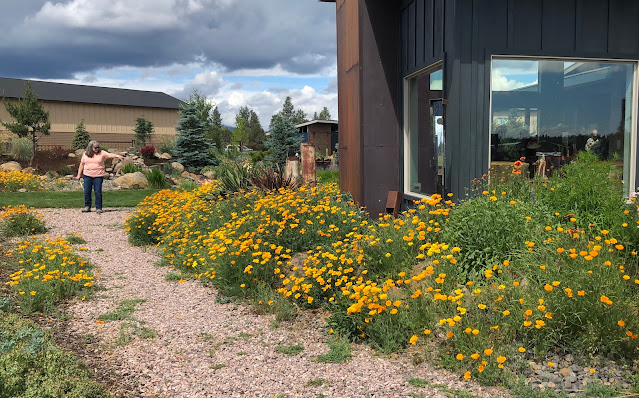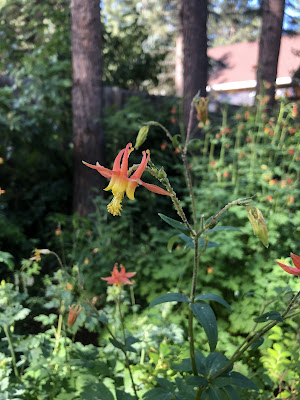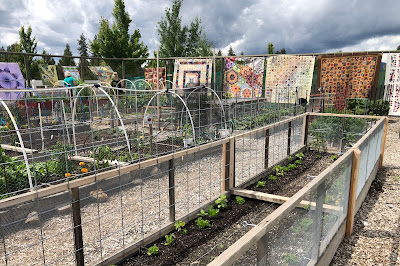
Visiting gardens in central Oregon for fun and education

|
| California poppies put on a show in this Sisters, Ore., garden. (Photos: Kathy Morrison) |
The house was not far from the local airstrip, but with a stunning view of mountains still wearing a white cap of snow. The walls and fences for this special event were hung with intricate quilts, most of modern design. Garden decor include many freestanding pieces by the owner, a metal sculptor. The whole site appealed to my collective creative delights.
But I was surprised — and then amused to be surprised — when I turned a corner into the garden and saw the huge bank of blooming California poppies ( Eschscholzia californica ). Wait, part of my brain said, why are homeowners in central Oregon growing California’s state flower?
Because, of course, they can.
It was a good reminder that the West Coast states are linked botanically. (Most of my poppies are long dead, pulled out about a month ago.) The gardens we visited around Sisters, Ore., this week proved more intriguing to me than the quilts hung there — though the quilts were indeed lovely.
The fundraising self-guided tour was presented by the Sisters Garden Club, the first time since 2019 the gardeners have been able to schedule it.

|
|
Western columbine in bloom.
|
Very few tomatoes were evident in the vegetable gardens, and the one basil I spotted was in a pot, protected from deer by chicken wire.
We also were able to visit the local community garden, another quilt display site. I zeroed in on the plots, which were about 4-by-12-feet. Many had small fences or even cages over the soil, and I asked one of the gardener hosts why.
“Sage rats,” she said with a tone of disgust. “And mice. We were hit really bad last year. This year’s better so far, but …” She looked out over the garden. “Last year my garden was eaten to the ground, like someone took a lawnmower to it.”

|
| The Sisters community garden, with quilts. |
And here I was envying the Sisters weather. (It rained here twice this week.) Sacramento gardeners do complain about the scorching heat, but at least we’re not battling sage rats!
Comments
0 comments have been posted.Sacramento Digs Gardening to your inbox.
Sites We Like
Garden Checklist for week of April 21
This week there’s plenty to keep gardeners busy. With no rain in the immediate forecast, remember to irrigate any new transplants.
* Weed, weed, weed! Get them before they flower and go to seed.
* April is the last chance to plant citrus trees such as dwarf orange, lemon and kumquat. These trees also look good in landscaping and provide fresh fruit in winter.
* Smell orange blossoms? Feed citrus trees with a low dose of balanced fertilizer (such as 10-10-10) during bloom to help set fruit. Keep an eye out for ants.
* Apply slow-release fertilizer to the lawn.
* Thoroughly clean debris from the bottom of outdoor ponds or fountains.
* Spring brings a flush of rapid growth, and that means your garden is really hungry. Feed shrubs and trees with a slow-release fertilizer. Or mulch with a 1-inch layer of compost.
* Azaleas and camellias looking a little yellow? If leaves are turning yellow between the veins, give them a boost with chelated iron.
* Trim dead flowers but not leaves from spring-flowering bulbs such as daffodils and tulips. Those leaves gather energy to create next year's flowers. Also, give the bulbs a fertilizer boost after bloom.
* Pinch chrysanthemums back to 12 inches for fall flowers. Cut old stems to the ground.
* Mulch around plants to conserve moisture and control weeds.
* From seed, plant beans, beets, cantaloupes, carrots, corn, cucumbers, melons, radishes and squash.
* Plant onion sets.
* In the flower garden, plant seeds for asters, cosmos, celosia, marigolds, salvia, sunflowers and zinnias.
* Transplant petunias, zinnias, geraniums and other summer bloomers.
* Plant perennials and dahlia tubers for summer bloom.
* Mid to late April is about the last chance to plant summer bulbs, such as gladiolus and tuberous begonias.
* Transplant lettuce seedlings. Choose varieties that mature quickly such as loose leaf.